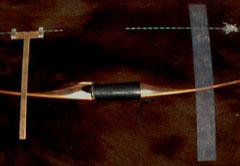TILLERING YOUR BOW
Now that your bow is completely shaped
and able to be strung, the next step (after you've shot
it a time or two of course) is tillering the limbs. First lets
take a look at the definitions of tiller and tillering.
Tiller is the difference between the upper limb and lower limbs
measurements from the bowstring to the belly at the fadeouts.
Bows are traditionally tillered to produce a stiffer lower limb;
ie, the bowstring to belly measurement on the lower limb is less
than the same measurement on the upper limb.
Tillering is the adjustment of tiller by removing material
from a bow limb or limbs. Most bows are tillered to approximately
1/8" - 1/4" positive measurement on the upper limb,
when the bow is to be shot split fingered. I tiller my bows even
for a 3-under shooter. The following picture shows two methods
of measuring, one using a bow square and the other a clear plastic
ruler. Make sure that you always measure perpendicular to the
string for the greatest accuracy.

The methods used to tiller a bow are quite simple. One method
to use is to slightly narrow the strong limb. Another method
is rounding the edges of the limb and the 3rd method used is
to flat sand the fiberglass, thereby reducing the thickness of
the limbs. Remember to go slow here, since removing material
is easy but putting it back is impossible.
Once I get a bow to where I think it is close, I will then string
it, put a nockset on and go outside with nockset pliers in my
back pocket, and fling some arrows. I then tune the bow
by adjusting the nocksets location until I don't see any porpoising
of the arrow. If the nock set is unusually high I then
take the bow back in and readjust the tiller.
Bows will vary on the amount of necessary tiller depending on
design

